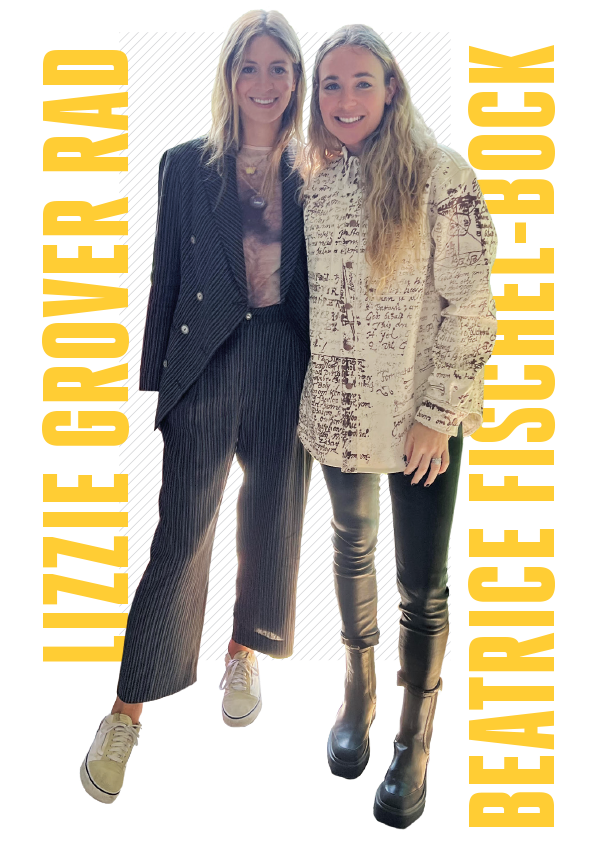Designed for Impact
Alumna Lizzie Grover Rad Has launched a fashion line that aims to start conversations.
Lizzie Grover Rad, B.F.A. ’14, isn’t afraid of challenges or controversy. After co-founding two highly successful interior design companies, ZOOM (started as a GW student) and Hutch (featured on Shark Tank and estimated value of $50 million), Grover Rad pivoted to fashion during the pandemic.
Her eponymous first collection, launched to fanfare earlier this year, focused on reproductive rights, incorporating a striking range of designs from cartoons to images that draw on the Salem Witch Trials and the Scarlet Letter. A wearable history of women’s struggles to gain control of their own bodies.
Grover Rad’s new venture includes her longtime friend and business partner, Beatrice Fischel-Bock, B.F.A. ’13. The two met at GW and started ZOOM and Hutch together.
GW Magazine talks to them about how they got their start, what inspires them and what’s next.
How did you two meet?
We met in our very first interior design class. We are both very shy but were attracted by each other’s outfits and struck up a conversation. It’s strange how in life you just gravitate and connect with some people and from the get-go we were like soul sisters. Lizzie had transferred to GW, and Bea had last minute decided to try the interior architecture program. It felt very kismet that we met.
You started ZOOM while undergrads at GW. How did that come together?
The three of us [with Madeline Fraser, B.F.A. ’14] started ZOOM our junior year when we realized how many of our peers couldn’t figure out how to furnish their dorms and apartments. It came easily to us without spending a big budget. We all had full course loads, part-time jobs and did ZOOM on the side. It was a lot of work, but we were having so much fun doing it. We would virtually design for our clients and have all the inventory shipped to our dorm rooms. Then on the weekends we would rent a van and install the design. We were painting furniture, building Ikea furniture, drilling in curtains. We got very good at DIY! By the time we graduated we had brought in a million dollars in gross revenue and knew we were on to something.
Why did you turn from interior design to fashion? Is there more freedom than there is with interior design?
ZOOM, then Hutch, was almost a decade-long journey. So much of the digital design landscape changed during that time. When we started people weren’t even sure about ordering furniture online. Now it’s a no brainer. Our company became a lot more about the tech we were building than creativity. We were no longer doing what lit us up and what started it all in the first place. Fashion is a lot freer. It’s more like art. Interior design is about the inhabitant’s needs and wants. There’s a lot of constrictions.
Grover Rad’s first collection couldn’t be more timely with a range of designs that focus on reproductive rights. When did you decide to do that, and why is it important to you?
Lizzie came up with her fashion brand during the pandemic. Slowing down finally gave her the space to be much more creative. From the get-go she knew social issues would be at the heart of her brand. It’s almost impossible to not have what’s going on around us influence you. We of course didn’t know that Roe v. Wade would be overturned right after we launched, but it was unfortunately not a huge surprise. Contemporary issues that we grapple with are rooted in history and unfolding that on a topic like reproductive rights surfaced a lot of inspiration.
Why is it important to you to have clothes that are conversation starters?
Clothes are a form of communication. There’s a famous monologue from the Devil Wears Prada in which Meryl Streep talks about Anne Hathaway’s sweater and what it says about her. You gather information from what a person is wearing. Art is another way people communicate without speaking. Marrying the two is at the heart of Grover Rad.
What’s next? Will all the collections be thematic?
Our second collection came out in October and is titled Billionaires in Space. Lizzie explores the fact that white rich men are exploring space travel and leaving Earth behind rather than dealing with the dire circumstances at home. Along with historical astronomical drawing and apocalyptic paintings, we imagine a different post-apocalyptic future of a planet ruled by women.
Also, have to ask, any favorite GW memories?
We went on some pretty amazing field trips! D.C. has such a wealth of architecture both historic and new. It was really fun to go out and explore the city with our sketchbooks. We also loved our interior architecture professors. They made such an impact and are near and dear to our hearts.
Courtesy of Grover Rad



